Psychosonics and the Modulationof Public Space
On Subversive Sonic Techniques
November 1, 2005essay,
Artist Mark Bain’s work focuses on the interaction between sound, architecture and public space. Triggered by the emergence of new sound techniques for crowd control, he reflects on ‘psychosonics as an invisible tactile material to provoke a public’, using William Burroughs’ ‘audio virusses’ and his own sound art as points of reference.

It’s true, it’s here and now! The use of advanced sound technologies to control public space. For years the speculation and the rumors over the Internet and other sources have been describing sonic weapons and non-lethal devices for crowd control and personnel dispersal as a science fiction reality. Some of these have been true, some half-true, and others pure fiction. From infrasound to ultrasound, the whole spectrum of frequencies to control human behavior and physical functioning has been ruminated on, but with sparse evidence to back it up.1 But now the Israeli military have unveiled something they like to refer to as The Scream2 – used to help control public demonstrations from both the Palestinians and Jewish settlers. It’s the horns of Jericho all over again but as a tactical inversion.
Actually, sonic techniques for subjugating the public have been used for years. Since the advent of sound reproduction and amplified playback, public address systems have been incorporated into locations or onto vehicles for information dispersal and propaganda uses. In former eras it was the church pulpit and town crier which acoustically informed. We’ve all heard the subliminal advertising used to sell soda and popcorn and listened to insipid Muzak, which drives workers and consumers into endless cycles of brain deadening stimulated relaxation.3 Since the Vietnam War, the brute force of rock and pop was harnessed to distract and annoy enemies of the state, as one post to a dedicated web page states:
The us Armed Forces in Panama, where in 1990 former cia employee, Manuel Noriega, barricaded himself in the Vatican Embassy in Panama City. For 10 days the Army bombarded him with pop music, loud hits, message songs such as Martha and the Vandellas’ Nowhere to Run and You’re No Good by Linda Rondstadt.
In 1991 heavy metal by such bands as Metallica was employed to harass the Iraqi troops into surrendering during the Iraq Crisis.
During the siege at Waco, Texas, atf agents employed sounds such as Tibetan chants (deep unsettling growls) to unnerve the Branch Davidians. Other songs employed were Billy Ray Cyrus’ Achy Breaky Heart and Nancy Sinatra’s These Boots Were Made For Walkin.4
At last, popular music put to proper use. But now in Israel and also Iraq (and soon at a demonstration near you), military forces have been testing a whole new category of sophisticated devices. With names like Hyper Sonic Sound (hss), Long Range Acoustic Device (lrad), and The Scream, technology has been developed which can now generate acoustic trauma at an extended range. The techniques for the most part utilize high frequency ultrasound to focus intense sonic energy at specific subjects. Imagine a bright spotlight only produced with sound, with directional beams which can penetrate the scull and stimulate the internal ear to cause physical trauma, imbalance, nausea and the need to escape its path. Imagine something that can generate voices in your head. One of the tactics uses ultrasound as a carrier frequency to send disconcerting messages. Programming material includes the sounds of screaming babies played backwards, or warning messages as narrow cast translations, and if that doesn’t work, harmonic pain pulses at 150db a shot (much louder than a jet engine). Yes, finally, the subtle and not so subtle art of acoustic persuasion has arrived.5
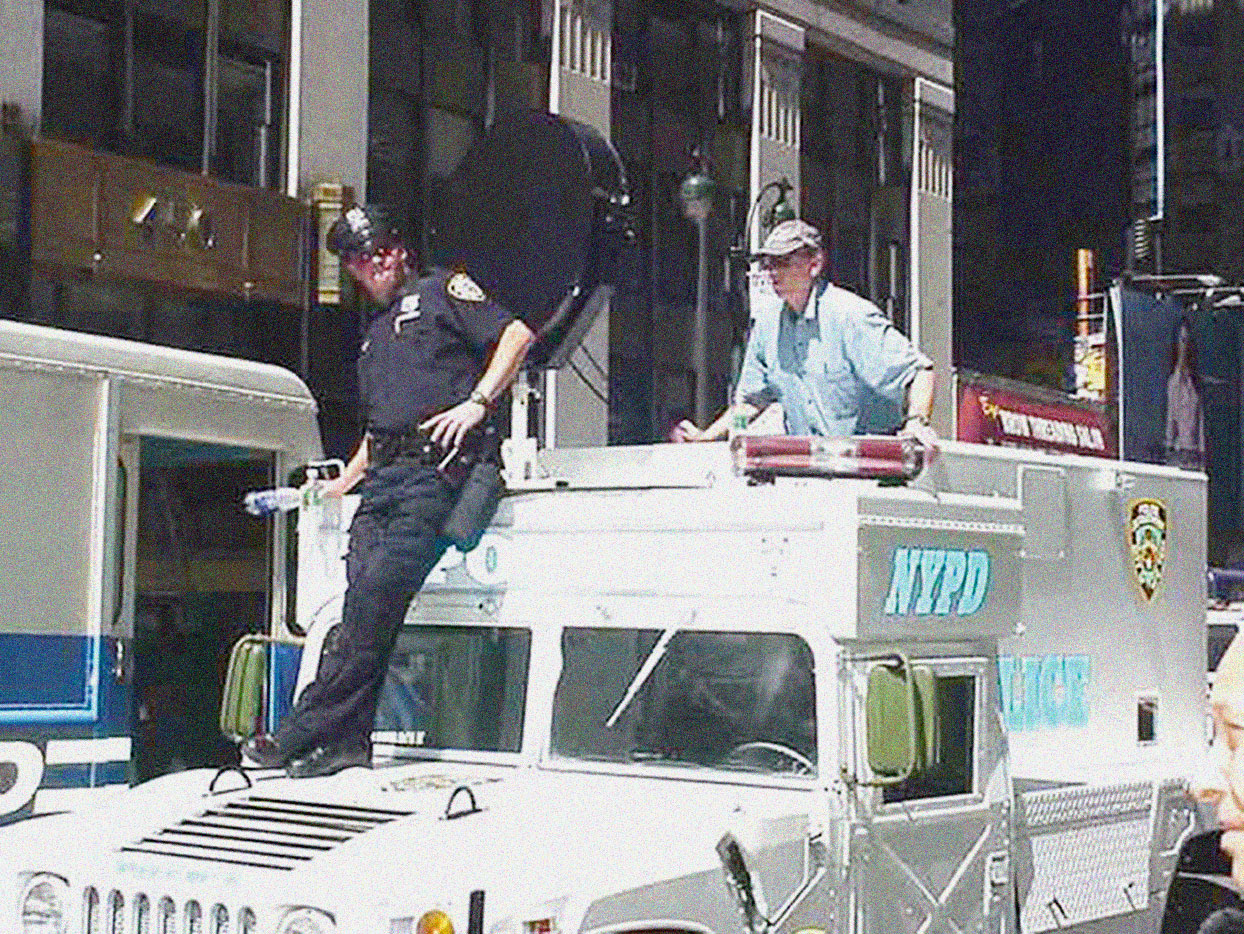
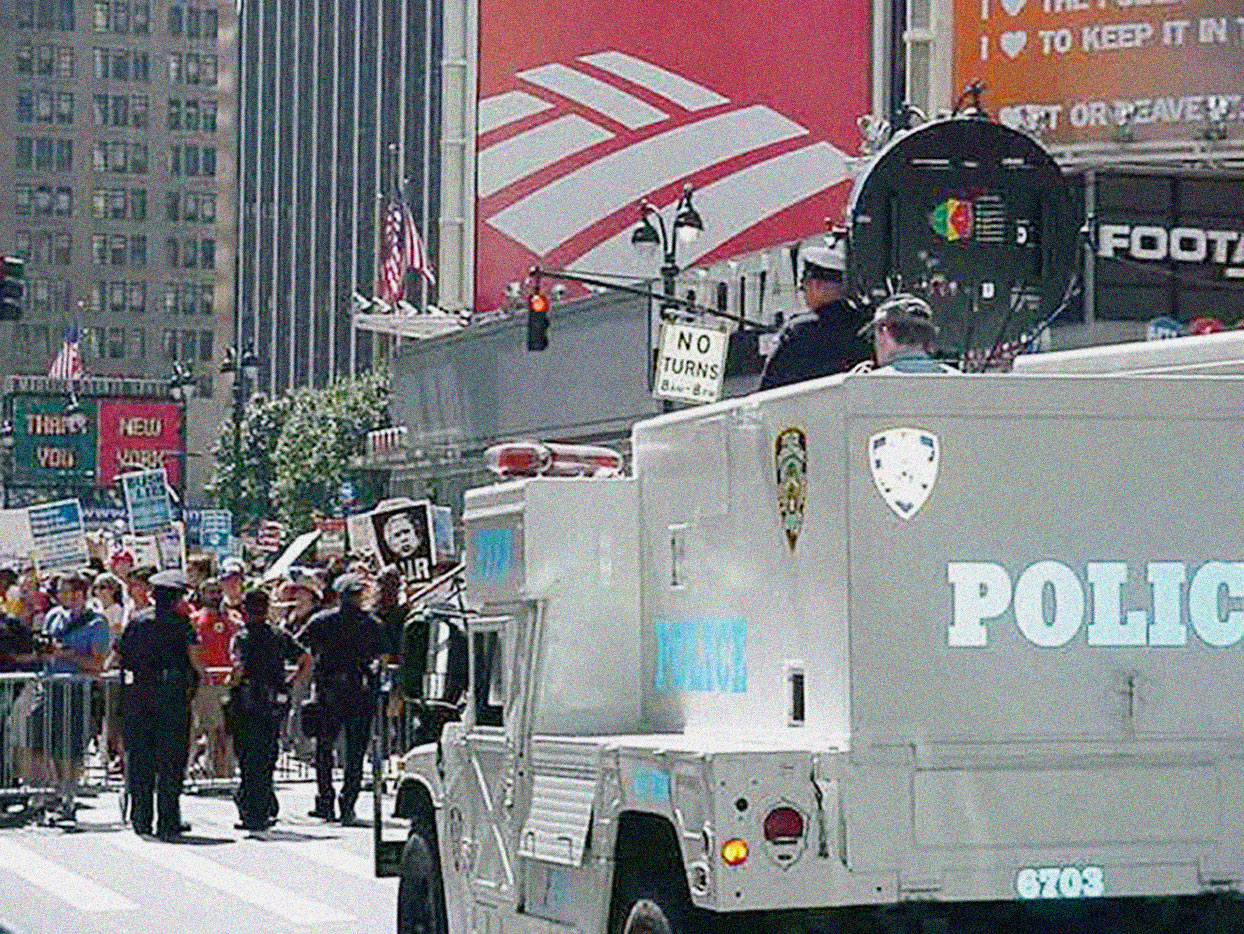
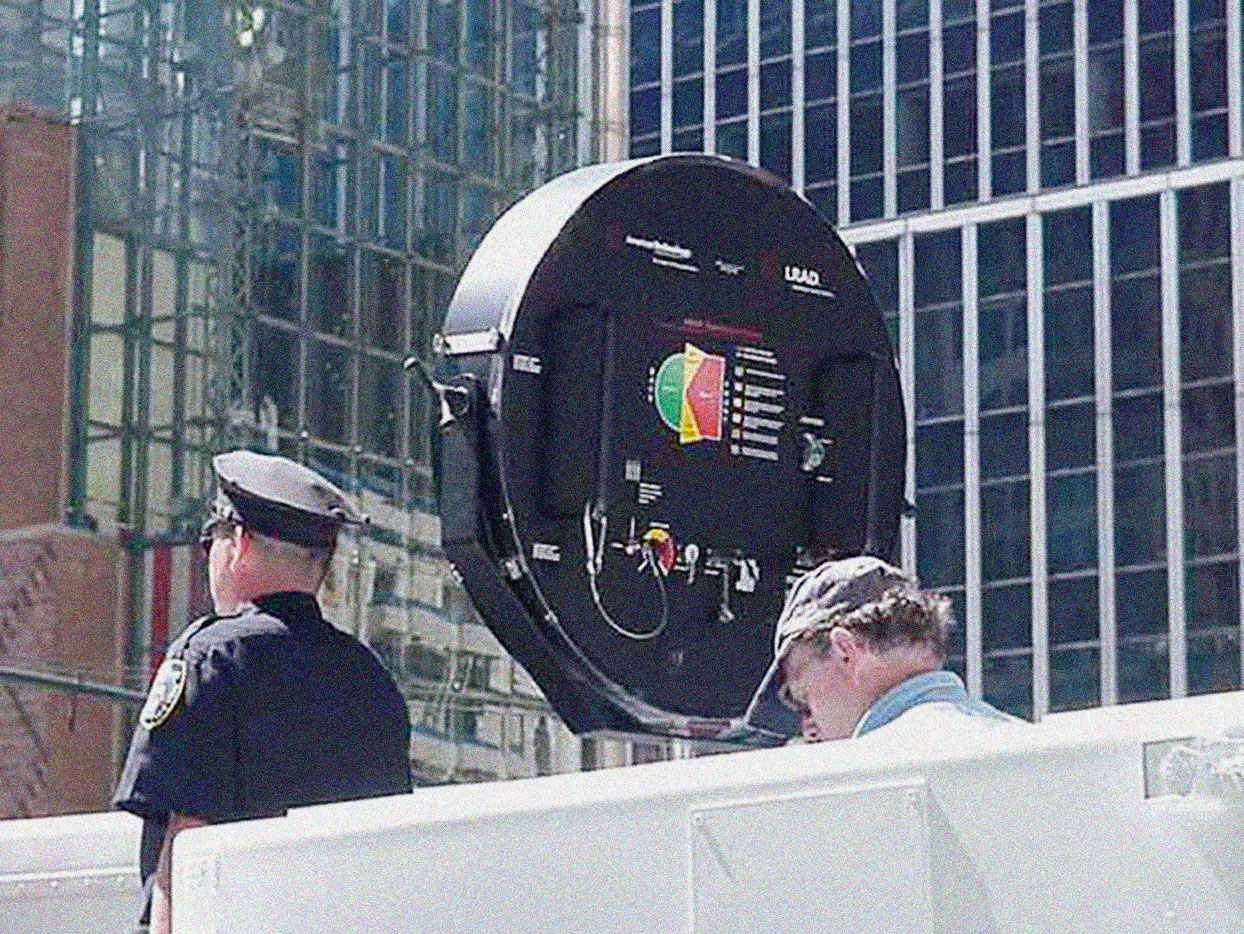
After the Battle in Seattle, the events of September 11 and the so-called War on Terror, non-lethal weapons development has ramped up and manifested into a growth industry. Along with the use of acoustics, other techniques include Active Denial Technology (ADT), a microwave based non-lethal pain ray which cooks on the inside, or something called Funky Foam which is sprayed onto large gatherings of people to literally glue them to the pavement.6 Or the opposite, super slicking agents that make it impossible to mobilize. These are just a few examples of the strange systems currently under development which attempt to control the use of public space.
With every new tactic, though, counter tactics are also developed. Already protesters are seen wearing motorcycle helm s and body armor and looking quite similar to the robo-cops attacking them. But with this new generation of acoustic weaponry, simple earplugs and earmuffs don’t offer much protection. One suggestion involves the use of mirroring.7 Because these sound rays are tightly focused and beamed at the target using high frequency ultrasound, a simple parabolic dish, such as a small satellite dish, can be used as a passive reflector to bounce the signal back to the operator. If properly designed and held in front of the head, this device can create a safety shadow to deflect the incoming sound waves. Perhaps this reflector could be worn like a mask, made of transparent plastic so as to not impede vision and also have an active component that could amplify the protesters own message. Future battles fought on the streets could look quite strange.
The Theory of the Audio Virus
In his 1970 essay The Electronic Revolution,8 William Burroughs outlines some other techniques to provoke public space using acoustic methods. Derived from his experiments with the ‘cut / up’ and the physical re-ordering of texts to make new texts, he suggests some ways that sound in public space can also be cut / up and re-ordered using simple tape recorders and portable playback systems. Expanding on his theories of the ‘word virus’, this speculative text turns to sound and the production of the ‘audio virus’ to infect locations and individuals. Inspired by the Watergate tapes, which brought down Nixon, he sees audio as an engaging practice with which to confuse and disrupt information and official propaganda. He plays the game of bad cop, good cop and confused cop when describing the three types of tapes with which to engage a target.
We now have three tape recorders. So we will make a simple word virus. Let us suppose that our target is a rival politician. On tape recorder 1 we will record speeches and conversation carefully editing in stammers mispronouncing, inept phrases... the worst number 1 can assemble. Now on tape recorder 2 we will make a love tape by bugging his bedroom. We can potentate this tape by splicing it in with a sexual object that is inadmissible or inaccessible or both, say the senator’s teen-age daughter. On tape recorder 3 we will record hateful disapproving voices and splice the three recordings together at very short intervals and play them back to the senator and his constituents.9
The key to this technique is the re-ordered use of the target’s own voice along with acoustic material that is familiar to him personally. This type of playback adds to its subliminal authenticity. Even though the information may be garbled and confused, the virus stays intact to disrupt the flow of thought and hijack propaganda. Some forms of propaganda use similar techniques to sway the masses and deflect information, perhaps Burroughs’ ideas can also function as a mirroring device to neutralize the operator’s intentions.
In 1966 a colleague of Burroughs, Ian Sommerville, was already experimenting with tape recorders. ‘He had discovered that playback on location can produce definite effects. Playing back recordings of an accident can produce another accident.’ For Burroughs this ‘playback is the essential ingredient’ in creating a slippage or feedback between the real and the induced artificial. He states that this ‘illusion is a revolutionary weapon’ used ‘to spread rumors’, to ‘discredit opponents’, to use ‘as a front line weapon to produce and escalate riots’ and ‘as a long range weapon to scramble and nullify associational lines put down by the mass media’. He imagines a small ‘trench-coat’ army outfitted with portable devices where: ‘Protestors have been urged to demonstrate peacefully, police and guardsmen to exercise restraint. Ten tape recorders strapped under their coats, playback, and record controlled from lapel buttons. They have pre-recorded riot sound effects from Chicago, Paris, Mexico City, Kent / Ohio. If they adjust sound levels of recordings to surrounding sound levels, they will not be detected. Police scuffle with the demonstrators. The operators converge. Turn on Chicago record, play back, move on to the next scuffles, record playback, keep moving. Things are hotting up, a cop is down groaning. Shrill chorus of recorded pig squeals and parody groans.’
‘Could you cool a riot by recording the calmest cop and the most reasonable demonstrator? Maybe! However, it’s a lot easier to start trouble that to stop it.’10
Further on Burroughs relates the technique of the audio cut / up to the original speech-scrambling experiments dating back to 1881. Normally speech scramblers are used to control the relay of information between two or more parties. Used as an encryption device for radio and telephonic communication, the technique provides a secure line that makes it difficult for outside snoopers to decode or interpret. In its current form, scramblers are electronic devices spoken through which encode language as unintelligible sound. Only by using the matching decoder can the message be re-presented as originally intended. In this in-between space of the garbled message, Burroughs locates his cut / up as a pure form of message received outside the norms of human perception. He sees people acting as conditioned decoders, massaged by the medial spew and reactive to its content. The cut / up acts as the ‘monkey wrench’, disturbing this pure space of conditioned bodies. The message, encoded and processed, is fed back and decoded by the same target subjects. As he states: ‘remember that when the human nervous system unscrambles a scrambled message this will seem to the subject like his very own ideas which just occurred to him, which indeed it did.’11
This shifting of public space, the scrambling and reorganizing of information and location though acoustic means, is something that the newer technology outlined above shares with Burroughs’ ideas. Both control and manipulate with sound, utilizing a collection of subtle and not so subtle techniques capable of moving crowds. Burroughs, though, is the prankster provoking the dominant ideologies, sending messages to the collective unconscious to be processed amorphously by the masses. The technologists on the other hand are searching for the pure acoustic bullet of direct control. Both could inform each other and both can neutralize the other, acting out a sonic war of sound in space and tactical strategizing.
Psychosonic Experiments
In my own work, I have developed a few systems that experiment with some of these ideas, designing portable acoustic devices, which play with public space in real time. For the most part these works stand in an ideological neutral zone without direct political content yet they still provoke in interesting ways. In the summer of 2004 I was working in Istanbul on a show called ‘hit n’ run’ which put together urban performances in public spaces. I had a project titled Action Unit: Instant Riot for Portable People, which consisted of a loud battery-operated sound system on wheels. There was a small bass speaker with an amplifier and a separate stand with two large pa horns. The horns I acquired in Istanbul, since I knew they would have them for the mosques. The programme material I made for this system was 40 minutes of rage, a collection of protests from around the world mixed to reflect conflicting opinions yet share the same anger in different languages. It presented a kind of Babylonian freak out which lacked any ideological content. I spent two months collecting over the radio, cable and Internet, personal video uploads, news reports and audio files of protestation, sounds which when editing together, seemed to permeate certain base centres of the brain. At times I would have this sound still in my head triggered by ambient noises for up to an hour after leaving the editing room, a kind of acoustic trauma with a latent hangover effect.
In using the system, I would go to public spaces and play this sound, a sound that everyone knows, but which is abstract enough that direct information isn’t being relayed. It was only the sound, without the protesters nor the banners nor the ideology, a virtual sound infecting an otherwise normal scene. Outside the Platform gallery, which is sited on one of the busiest shopping streets, I set the unit up with a sound level that matched the shops next door blasting Western and Turkish pop music to attract visitors. It played a total of 6 min 40 sec and by then a small riot had ensued, a crowd of people assembled, some yelling, others messing with the equipment and shoving me around, then the police arrived and shut it down for good. It proved to be an interesting experiment in behaviour activation and the half-hour discussion it generated afterwards on the street was informative and relevant to these times –the NATO riots had taken place a few weeks before. One American journalist who happened to pass by said it made him shake in the knees (he hated it). The ethics of this work could also be discussed, along with how certain sounds can affect a group psychosis.
Another work presented in 2003 in a former shopping centre in Lyon, titled A Simulation of a Reconstruction by Remote Means, involved a compact high powered sound system, a sound chip and a mobile phone. On the sound chip I recorded the sound of the actual explosion of the UN bombing in Baghdad, one of the few terrorist bombs that was picked up on camera as it was happening. This piece, sited in the gallery’s front window was quiet until one dialed the number of the attached phone. The number was distributed on random e-mailing lists and also on flyers related to the show. Anywhere in the world, one could call and trigger the playback of this sound file. A direct link is made to the advanced triggering mechanisms such as those used in the Bali bombing and later on in Madrid, which coupled mobile communication technology with terrorist actions. At a time when the world seems bomb crazy, this piece allows the world to call and bomb the world, or at least simulate it. It’s just a number far removed from the point of impact, and if you misdial, perhaps it’s a real one. As a simulation, it created an unpredictable action connected to the outside but which permeated a point of location in the gallery space. The remote spectator is the activator, generating a sonic punctuation in space that affects the local spectator, endlessly repeated with absurd proportions as each call is made: replaying an attack on the United Nations over and over and over again. This work lasted for three days at which point, due to extreme usage, it literally self-destructed. Repairs were made and the action continued for the duration of the show.
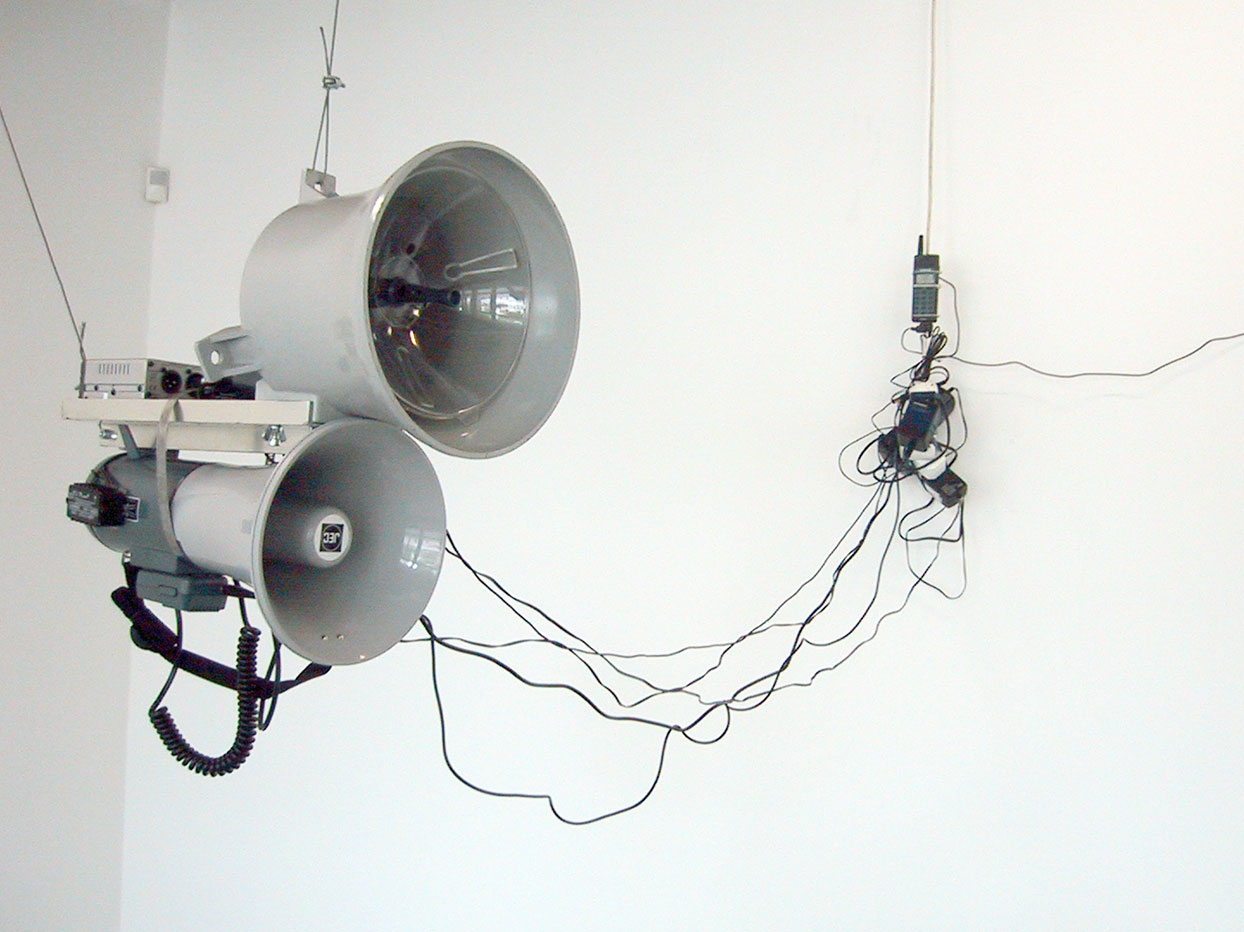
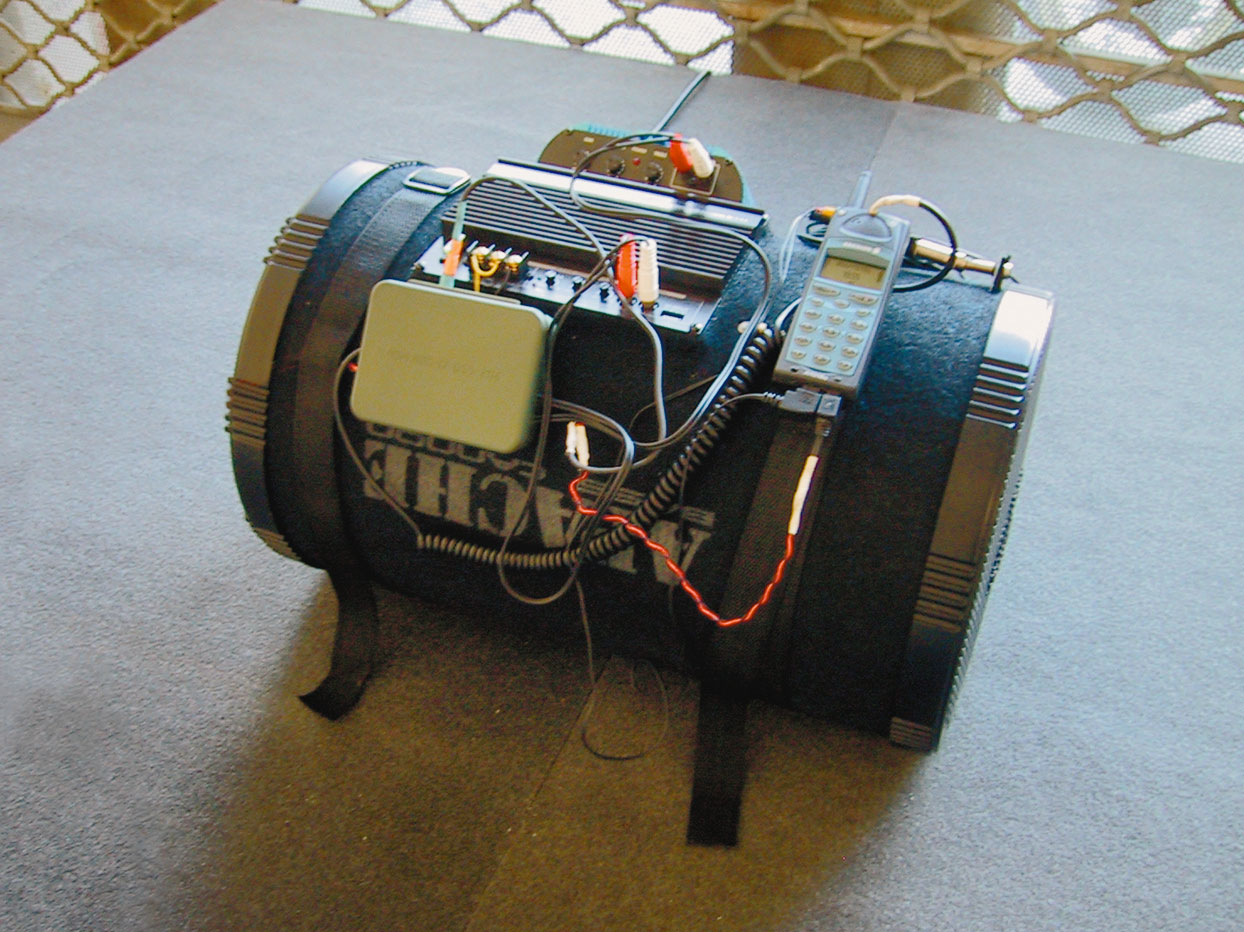
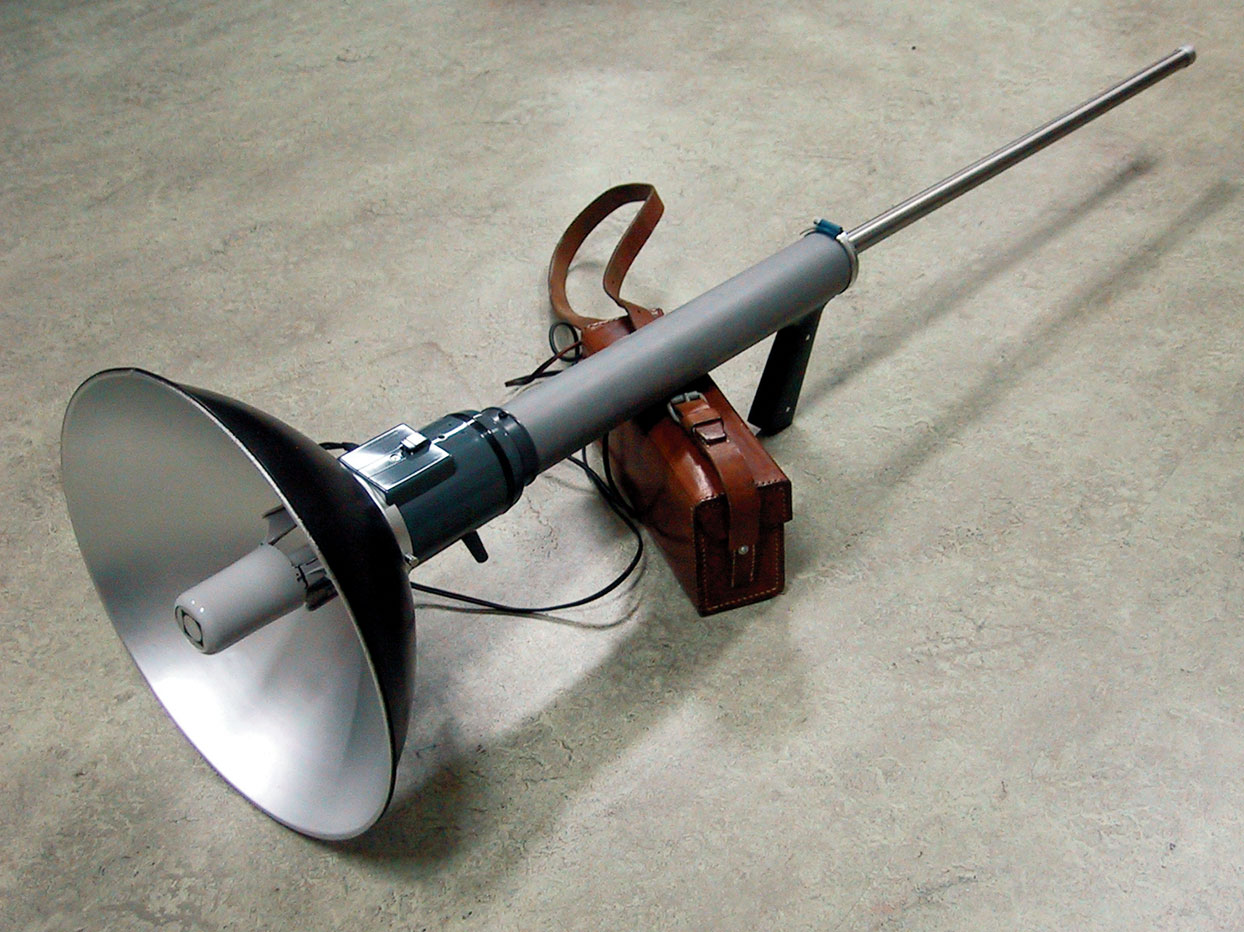
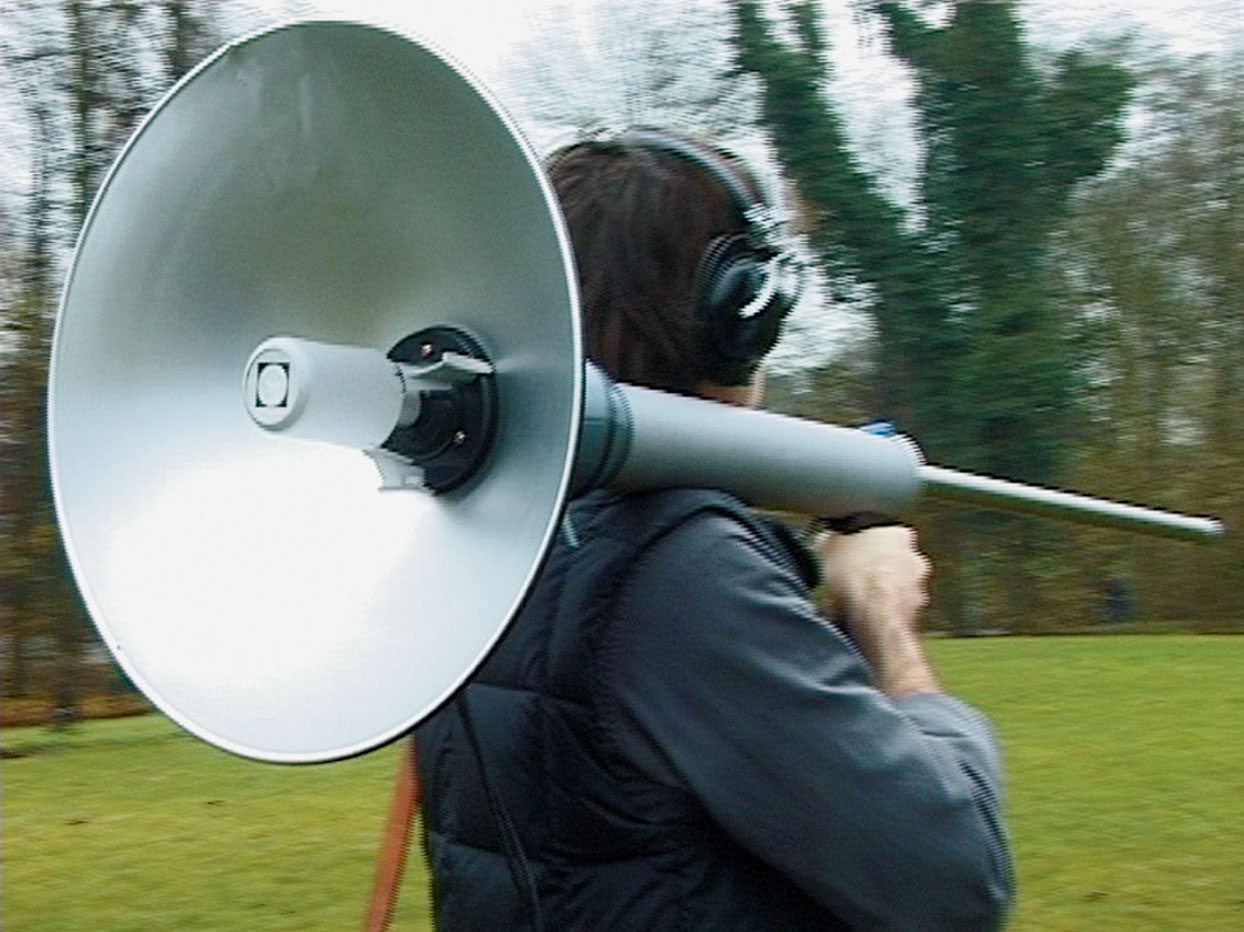
An earlier project which also made use of mobile phones was a work titled Contact. This piece was designed for open public areas and consisted of two separate, modified PA systems mounted on light poles situated across a space but facing each other. Each unit had a directional microphone and a bullhorn directly connected to a mobile telephone that worked as an extension of the voice and ear. The two separate phone numbers were advertised in local publications and Internet listings as a free service to meet people, usually under the pretext of dating someone of the opposite or same sex. A person could call and their voice would be projected into this outside location, the phone acting as a megaphone to publicly address. If lucky, another person was on the other line talking through the second system, allowing them to have a conversation while simultaneously being monitored by the outside audience. As if in a magnified conference call, these secondary spectators could also converse with the callers by just talking towards the PA units. Here, private becomes public and the outsider becomes the interloper, witnessing and disrupting the personal conversation of unwitting participants. It can be seen as an act of strangers listening to strangers talking to strangers, an amplification of communication and confusion.
The last project I’ll describe is the recent Acoustic Space Gun (ASG). This device is a linear sound shifter, which couples a metre-long directional microphone with a parabolic sound emitter pointed in the opposite direction. Used in public space, it collects live sounds and conversations at long distances from one side, then amplifies and presents them far out to the other. Looking like a shoulder mounted sonic weapon of sorts, slightly space age and designed for functionality, it operates as an absurd spatial megaphone, which monitors the crowd in spaces to re-project and shift the natural dynamics of acoustic location. Coupled to the microphone input is an electronic circuit that can add up to 900 metres of delay to the signal. This adjustable delay line allows you to shift the sonic footprint of a certain space, producing a forced echo or canyon effect, which adds to the spatial feedback. Acting as a live mixing instrument, shifting the natural sounds and provoking other levels of hearing, the device is played at a level comparable to the surrounding ambiance. This subtlety added to the confusion, suddenly people can hear their voices coming from alternate directions and in other time frames, echoing off of building façades and twisting the normalcy of public sound.
Psychological impact
Each of these works incorporates the public as performer within the content and distribution of the sound. Locations and actions are amplified via simple technical devices, sometimes causing unpredictable situations, but which somehow integrate spatial acoustics with the people involved. Here ‘psychosonics’ functions as an invisible tactile material to provoke a public. Whether through the antics of Burroughs’ propositions, the actions of police forces or with the experiments I’ve carried out, this subtle art is something most people don’t recognize: that the ear is a conduit for psychological affect. Even natural ambient sounds of the city or countryside can induce a type of trauma that mostly goes unnoticed. An idling truck or even atmospheric changes in the weather can generate large amounts of infrasound (low frequency sound below the threshold of hearing). These unheard sounds may produce feelings of fear and anxiety, while the din of general noise pollution can also provoke the same thing. Humans are adaptable creatures, adjusting to environmental situations and selectively filtering sensory input. We can choose to look away or close our eyes to that which is visible, but it’s more difficult to shut out the audible. Our ears adapt to the noise, yet our brain still takes it in.
1. Stuart Swezey (ed.), Amok Journal: Sensurround Edition – A Compendium of Psycho-Physiological Investigations (Los Angeles: Amok Books, 1995).
2. Associated Press, Israel May Use New Weapon on Settlers, 10 June 2005, www.foxnews.com.
3. David Sutton, ‘Sonic Doom’, in: Fortean Times 153, December 2001, an extensive overview of sonic control techniques, www.forteantimes.com.
4. Above Top Secret discussion board. Posted by: mOjOm. On: Fri June, 102005 @ 16: 56 GMT, www.atsnn.com.
5. Associated Press, Troops Get High-Tech Noisemaker, 3 March 2004, www.cnn.com, www.defensetech.org.
6. Chicago Tribune, Pain Ray, Funky Foam Could Ease Iraq Woes, 20 December 2003, www.defensetech.org.
7. Mark Bain, Defensive Tactics for Projected Acoustic Trauma, authors edition, 2005.
8. William S. Burroughs, The Electronic Revolution (Germany: Expanded Media Editions, Bresche Publikationen, 1970), archive.groovy.net.
9. Ibid.
10. Ibid.
11. Ibid.
Mark Bain (USA) is a visual artist who lives in Amsterdam. His field of interest is the relationship between sound and architecture. One of his areas of research is the psychological effect of sound. He has had exhibitions at Rotterdam’s Boijmans van Beuningen Museum in 2004, the Platform Gallery in Istanbul in 2004, and the MACBA in Barcelona in 2003. See further: www.simulux.com.